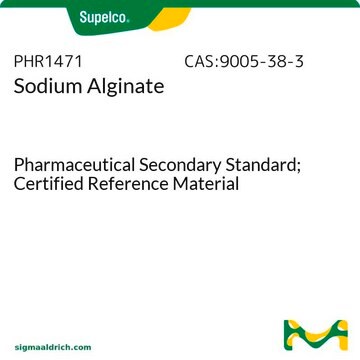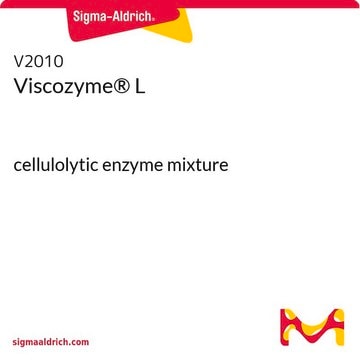Most information on this enzyme is proprietary. However, it is an endo-type enzyme sourced from Flavobacterium species and functions as an endo-cleaving enzyme.
A1603
Alginate Lyase
powder, ≥10,000 units/g solid
Synonym(s):
poly-beta-D-mannuronate lyase
Select a Size
Select a Size
About This Item
Recommended Products
form
powder
specific activity
≥10,000 units/g solid
storage temp.
2-8°C
General description
Application
- in the pre-processing of enzyme[2]
- to de-encapsulate cells[3]
- to digest Pseudomonas exopolysaccharide to facilitate electroporation[4]
Biochem/physiol Actions
Unit Definition
Preparation Note
Other Notes
Signal Word
Danger
Hazard Statements
Precautionary Statements
Hazard Classifications
Resp. Sens. 1
Storage Class Code
11 - Combustible Solids
WGK
WGK 1
Flash Point(F)
Not applicable
Flash Point(C)
Not applicable
Personal Protective Equipment
Choose from one of the most recent versions:
Certificates of Analysis (COA)
Don't see the Right Version?
If you require a particular version, you can look up a specific certificate by the Lot or Batch number.
Already Own This Product?
Find documentation for the products that you have recently purchased in the Document Library.
Customers Also Viewed
-
Hi! What is the PL family, source and structure of this enzyme?
1 answer-
Helpful?
-
-
What are the aminoacid sequence of the enzyme, molecular weight, molar extinction and the original bacterium
1 answer-
The amino acid sequence and molar extinction of this enzyme has not been determined. The molecular weight is approximately 40,000 daltons. The specific species of the bacterium is considered proprietary.
Helpful?
-
-
Hi, could you please tell me the source of the alginate lyase and the strain in which it was expressed? Thank you!
1 answer-
This enzyme is produced by microbial fermentation. The specific species is considered proprietary.
Helpful?
-
-
I was wondering how to prepare the enzyme solution and what does the 1 un/ml mean? Is is 1 unit/mL or what does the un stand for? How do I convert the units to grams?
1 answer-
A1603 should be resuspended at a concentration of 0.05 - 1.5 u/ml in 0.1 mol/L Phosphate buffer (pH 6.3).
The specific activity of each lot (units/gram solid) is provided on the certificate of analysis. The lot specific certificate of analysis can be found here:
https://www.sigmaaldrich.com/product/sigma/a1603#product-documentation
Based on the specific activity (units/gram solid), the researcher can weigh out the appropriate amount of A1603 to achieve a 1 unit/mL solution.
un = unitHelpful?
-
-
Hi, I've ordered this product from here, but it's just saying powder, ≥10,000 units/g solid, can you please tell me the molecular weight of it? in Da or kDa?
1 answer-
The molecular weight this material is approximately 40,000 daltons.
Helpful?
-
-
Do you have any information about solubility, for example in PBS pH 7.2? It would be helpful to know if activity is retained after a single freeze-thaw cycle, so that we could store concentrated aliquots at -20 C.
1 answer-
A pH of 7.2 will cause a decline in activity. Solutions of 0.05 - 1.5 u/ml prepared in 0.1 M Phosphate buffer at pH 6.3 are recommended to maintain optimum activity.
The general recommendations in the literature are as follows:
For long-term storage, store at -20°C or -80°C. Store working aliquots at 4°C for up to one week. Avoid repeated freeze/thaw cycles.
Note that the stability information above has not been validated .Helpful?
-
-
I ordered the alginate lyase from your company. But the information that I received only present >=10,000U/g. And I need the 20U/m in my experiment. Could you give me more information?
1 answer-
The exact specific activity value is specified on the lot specific Certificate of Analysis. Please see this example Certificate of Analysis: https://www.sigmaaldrich.com/certificates/sapfs/PROD/sap/certificate_pdfs/COFA/Q14/A1603-BULKSLCQ2940.pdf.
Helpful?
-
Active Filters
Our team of scientists has experience in all areas of research including Life Science, Material Science, Chemical Synthesis, Chromatography, Analytical and many others.
Contact Technical Service









